A Methodology for the Enhancement of the Energy Flexibility and Contingency Response of a Building through Predictive Control of Passive and Active Storage
Abstract
:1. Introduction
2. Literature Review—Enhanced Flexibility Through Optimal Control
2.1. Improving Energy Flexibility in Buildings
2.2. Predictive Building Load Management and Model Predictive Control (MPC)
3. Methodology
- Real building measurement data were collected from the BAS. Data included variables such as building power kW, zone air temperature, weather data, and specific data related to the ETS in question. Data were collected at 15-minute intervals.
- Numerical thermal building or device control-oriented models were developed. These models are physics-based ROM grey-box RC thermal networks. These models were then calibrated using the collected data from the first step. Critical parameters were identified using the gradient descent-based optimization function fmincon in MATLAB. A detailed explanation of the model development process for the ETS device is found in [4,38,39].
- Predictive control strategies for very cold days were identified for optimized peak load management and building energy flexibility by quantifying the BEFI depending on when a signal from the utility is given to the building owner. A heuristic approach was compared to optimized control MPC using fmincon in MATLAB. See Appendix A for further details on the developed BEFI.
- Shoulder season MPC studies were also performed with the goal of improving the operation of the ETS to reduce energy consumption by storing the appropriate amount of energy needed for a warmer shoulder season day. With current control methods, it is common for the device to become overcharged on warmer shoulder season days.
- Accounting for model prediction uncertainty due to weather forecast and identified model parameters was done by evaluating various uncertainty scenarios and by plotting the uncertainty bounds for the duration of the identified operation schedule.
- Contingency strategies were evaluated to quantify the energy flexibility available from the building to the grid at specific times. Two strategies were evaluated: (1) reducing the zone temperature setpoint for 3 h and (2) discharging the stored thermal energy in the ETS for 3 h.
3.1. Description of the Case Study Building and Electric Thermal Storage Device (ETS)
3.1.1. Description of the Case Study Building Zone
- : the electric power to the ETS providing heat to the brick storage medium,
- : the fan operation (ON/OFF), which notifies when air is passed through the brick storage medium,
- : the additional auxiliary heating supplied to the supply air.
3.1.2. Description of Thermal Energy Storage Device
3.2. Control-Oriented Thermal Model
3.3. Quebec Commercial Customer Electricity Rates
3.4. Predictive Load Management Scenarios
- 1.
- 2.
- Cost function using rate flex M: the second optimization problem in consideration is shown in Equation (4), where the objective is the minimization of the variable electricity cost shown in Figure 8. Equation (4) is a special case of Equation (3) but has an added variable energy cost over the day, indicated by subindex i, with higher cost during peak hours (Table 2).where N is the number of time steps over the prediction horizon (24, 36, 48 h, etc.), is the power demand at time i, and is the time step. The objective is to identify two variables that minimize the cost associated with the utility rate charge: (1) an optimized setpoint schedule for the room temperature and (2) the maximum charging power input to the ETS, . The setpoint is constrained by a lower () and upper () bound to maintain a level of thermal comfort for the zone occupants. The demand due to space heating P is constrained by the size of the heating equipment . Similarly, the maximum charging power input to the ETS is constrained by the specifications of the device, . Prediction control simulations are run at 5-minute intervals for higher time granularity and optimized values are identified at 1-hour intervals to speed up schedule identification.
- 3.
- Cost function using BEFI maximization during peak demand: the last optimization problem considered is using BEFI as the cost function. A BEFI is maximized during a specified period of the peak demand event.
3.5. Real-Time Optimizing Algorithm
3.6. Prediction and Control Horizons
4. Results and Discussion
4.1. Weather Conditions—Cold Winter Day
4.2. Demand Response with 12- and 4-Hour Notifications
4.3. Predictive Load Management Simulation
4.4. Shoulder Season Performance: Cold Day Followed by a Warm Day
4.5. Accounting for Prediction Uncertainty
4.6. Contingency Event Evaluation
5. Conclusions
Author Contributions
Funding
Institutional Review Board Statement
Informed Consent Statement
Data Availability Statement
Acknowledgments
Conflicts of Interest
Nomenclature
| t | Time step (seconds) or duration of flexibility event hours) |
| C | Thermal capacitance (J/K) |
| C | Thermal capacitance of brick storage medium (J/K) |
| c | Specific heat capacity (kJ/(kg· K)) |
| DH | Hydraulic diameter (m) |
| h | Heat transfer coefficient (W/(mK)) |
| J | Objective function |
| k | Thermal conductivity (W/(m·K)) |
| L | Length of air channel (m) |
| Mass flow rate (kg/s) | |
| M | Volumetric flow rate (m/s) |
| N | Number of time steps |
| Nu | Nusselt number |
| P | Air channel perimeter (m) |
| PH | Prediction Horizon |
| P | Electrical heat input to storage medium (%) |
| P | Maximum input of ETS (W) |
| P | Reference power demand (kW) |
| P | Power demand of flexibility scenario (kW) |
| Q | Power (W) |
| Q | Electrical heat input to storage medium (W) |
| Q | Heat extracted from storage medium to air in channel (W) |
| q | Energy (Wh) |
| q | Convective heat flux (W/m) |
| q | Radiative heat flux (W/m) |
| R | Thermal resistance (K/W) |
| R | Thermal resistance of brick storage medium (K/W) |
| R | Thermal resistance of insulation layer (K/W) |
| R | Thermal resistance from surface to room air (K/W) |
| T | Temperature (C) |
| T | Room air temperature (C) |
| t | Time (seconds) |
| t | Time of notification of DR event |
| W | Width of air channel (m) |
| Z | Length in vertical axis (m) |
Greek symbols
| Emissivity | |
| Stefan–Boltzmann constant (W/(mK)) | |
| Density (kg/m) |
Subscripts
| i, k | Nodes of thermal network |
| p | Time step |
| Setpoint |
Abbreviations
| 1R1C | 1-Capacitance, 1-Resistance |
| BAS | Building Automation System |
| BEFI | Building Energy Flexibility Index |
| BAU | Business As Usual |
| C & I | Commercial and Institutional |
| CEMS | Centralized Energy Management System |
| CO | Carbon Dioxide |
| DR | Demand Response |
| DSM | Demand Side Management |
| ETS | Electric Thermal Storage |
| GHG | Green House Gas |
| HVAC | Heating, Ventilation, and Air Conditioning |
| IEA EBC | International Energy Agency in Buildings and Communities Programme |
| MAE | Mean Absolute Error |
| MPC | Model Predictive Control |
| RC model | Resistance-Capacitance model |
| RMSE | Root-Mean-Square Error |
| ROM | Reduced Order Model |
| TOU | Time-of-Use |
Appendix A. Concept of Building Energy Flexibility Index (BEFI)

Appendix B. Control-Oriented Thermal Modeling of the Storage Device
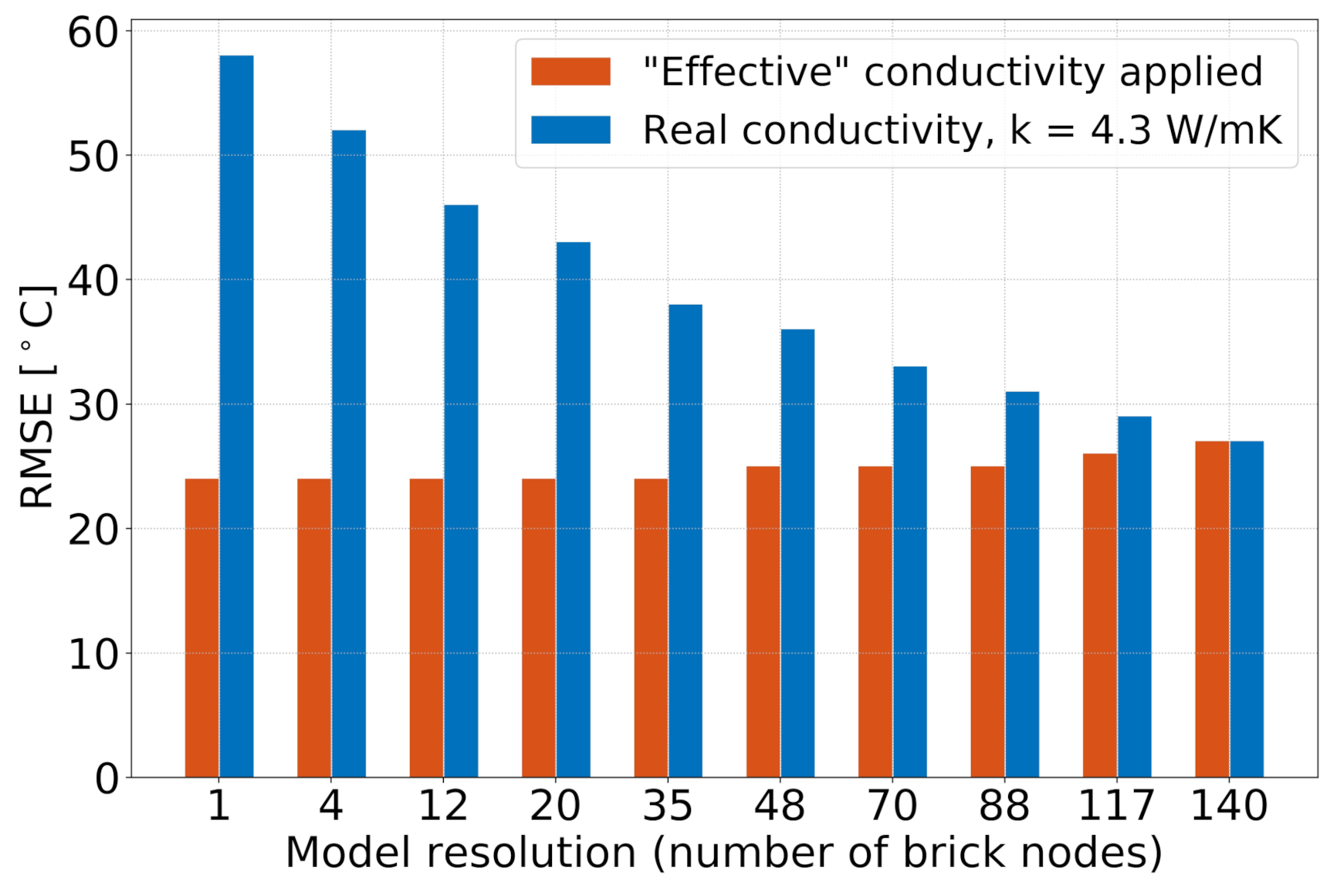
References
- Denholm, P.; O’Connell, M.; Brinkman, G.; Jorgenson, J. Overgeneration from Solar Energy in California. Field Guide Duck Chart 2015. [Google Scholar] [CrossRef] [Green Version]
- IEA. IEA EBC Annex 67. 2020. Available online: http://www.annex67.org/ (accessed on 1 February 2021).
- Athienitis, A.K.; Dumont, E.; Candanedo, J.A.; Morovat, N.; Lavigne, K.; Date, J. Development of a dynamic energy flexibility index for buildings and their interaction with smart grids. In Proceedings of the Aceee Summer Study 2020 Conference, Pacific Grove, CA, USA, 17–21 August 2020. [Google Scholar]
- Date, J.A.; Candanedo, J.A.; Athienitis, A.K.; Lavigne, K. Energy flexible building: Predictive load management of passive and active energy storage under a Demand Response Program. In Proceedings of the eSIM 2020 Conference, Vancouver, BC, Canada (Postponed), 15–16 June 2020. [Google Scholar]
- Hydro-Quebec. Annual Report. 2018. Available online: https://www.hydroquebec.com/about/financial-results/annual-report.html (accessed on 1 February 2021).
- Hydro-Québec Distribution. État D’Avancement 2012 du Plan D’Approvisionnement 2011–2020. 2012. Available online: http://www.regie-energie.qc.ca/audiences/TermElecDistrPlansAppro_Suivis.html (accessed on 1 February 2021).
- Qin, S.; Badgwell, T.A. A survey of industrial model predictive control technology. Control. Eng. Pract. 2003, 11, 733–764. [Google Scholar] [CrossRef]
- Sturzenegger, D.; Gyalistras, D.; Morari, M.; Smith, R.S. Model Predictive Climate Control of a Swiss Office Building. Proc. Clima Rheva World Congr. 2016, 24, 1–12. [Google Scholar] [CrossRef]
- De Coninck, R.; Helsen, L. Practical implementation and evaluation of model predictive control for an office building in Brussels. Energy Build. 2016, 111, 290–298. [Google Scholar] [CrossRef]
- Prívara, S.; Široký, J.; Ferkl, L.; Cigler, J. Model predictive control of a building heating system: The first experience. Energy Build. 2011, 43, 564–572. [Google Scholar] [CrossRef]
- Perera, D.W.U.; Winkler, D.; Skeie, N.O. Multi-floor building heating models in MATLAB and Modelica environments. Appl. Energy 2016, 171, 46–57. [Google Scholar] [CrossRef]
- Jensen, S.Ø; Marszal-Pomianowska, A.; Lollini, R.; Pasut, W.; Knotzer, A.; Engelmann, P.; Stafford, A.; Reynders, G. IEA EBC Annex 67 Energy Flexible Buildings. Energy Build. 2017, 155, 25–34. [Google Scholar] [CrossRef] [Green Version]
- Reynders, G.; Amaral Lopes, R.; Marszal-Pomianowska, A.; Aelenei, D.; Martins, J.; Saelens, D. Energy flexible buildings: An evaluation of definitions and quantification methodologies applied to thermal storage. Energy Build. 2018, 166, 372–390. [Google Scholar] [CrossRef]
- Le Dréau, J.; Heiselberg, P. Energy flexibility of residential buildings using short term heat storage in the thermal mass. Energy 2016, 111, 991–1002. [Google Scholar] [CrossRef]
- Hurtado, L.; Rhodes, J.; Nguyen, P.; Kamphuis, I.; Webber, M. Quantifying demand flexibility based on structural thermal storage and comfort management of non-residential buildings: A comparison between hot and cold climate zones. Appl. Energy 2017, 195, 1047–1054. [Google Scholar] [CrossRef]
- Weiß, T.; Fulterer, A.M.; Knotzer, A. Energy flexibility of domestic thermal loads–a building typology approach of the residential building stock in Austria. Adv. Build. Energy Res. 2019, 13, 122–137. [Google Scholar] [CrossRef]
- Vigna, I.; Pernetti, R.; Pasut, W.; Lollini, R. New domain for promoting energy efficiency: Energy Flexible Building Cluster. Sustain. Cities Soc. 2018, 38, 526–533. [Google Scholar] [CrossRef]
- Foteinaki, K.; Li, R.; Heller, A.; Rode, C. Heating system energy flexibility of low-energy residential buildings. Energy Build. 2018, 180, 95–108. [Google Scholar] [CrossRef]
- Junker, R.G.; Lindberg, K.B.; Reynders, G.; Lopes, R.A.; Relan, R.; Azar, A.G.; Madsen, H. Characterizing the energy flexibility of buildings and districts. Appl. Energy 2018, 225, 175–182. [Google Scholar] [CrossRef]
- Liu, M.; Heiselberg, P. Energy flexibility of a nearly zero-energy building with weather predictive control on a convective building energy system and evaluated with different metrics. Appl. Energy 2019, 233–234, 764–775. [Google Scholar] [CrossRef]
- Reynders, G.; Diriken, J.; Saelens, D. Generic characterization method for energy flexibility: Applied to structural thermal storage in residential buildings. Appl. Energy 2017, 198, 192–202. [Google Scholar] [CrossRef] [Green Version]
- Aduda, K.O.; Labeodan, T.; Zeiler, W.; Boxem, G.; Zhao, Y. Demand side flexibility: Potentials and building performance implications. Sustain. Cities Soc. 2016, 22, 146–163. [Google Scholar] [CrossRef]
- Sánchez Ramos, J.; Pavón Moreno, M.; Guerrero Delgado, M.; Álvarez Domínguez, S.F.; Cabeza, L. Potential of energy flexible buildings: Evaluation of DSM strategies using building thermal mass. Energy Build. 2019, 203, 109442. [Google Scholar] [CrossRef]
- Perez, K.X.; Baldea, M.; Edgar, T.F. ntegrated HVAC management and optimal scheduling of smart appliances for community peak load reduction. Energy Build. 2016, 123, 34–40. [Google Scholar] [CrossRef] [Green Version]
- Sharma, I.; Dong, J.; Malikopoulos, A.A.; Street, M.; Ostrowski, J.; Kuruganti, T.; Jackson, R. A modeling framework for optimal energy management of a residential building. Energy Build. 2016, 130, 55–63. [Google Scholar] [CrossRef]
- Patteeuw, D.; Henze, G.P.; Helsen, L. Comparison of load shifting incentives for low-energy buildings with heat pumps to attain grid flexibility benefits. Appl. Energy 2016, 167, 80–92. [Google Scholar] [CrossRef]
- Cigler, J.; Tomáško, P.; Široký, J. BuildingLAB: A tool to analyze performance of model predictive controllers for buildings. Energy Build. 2013, 57, 34–41. [Google Scholar] [CrossRef]
- Donghun, K.; Braun, J.E. Reduced-order building modeling for application to model-based predictive control. In Proceedings of the Fifth National Conference of IBPSA-USA, Madison, WI, USA, 1–3 August 2012. [Google Scholar]
- Kummert, M.; André, P.; Nicolas, J. Optimal heating control in a passive solar commercial building. Sol. Energy 2001, 69, 103–116. [Google Scholar] [CrossRef]
- Oldewurtel, F.; Parisio, A.; Jones, C.N.; Gyalistras, D.; Gwerder, M.; Stauch, V.; Lehmann, B.; Morari, M. Use of model predictive control and weather forecasts for energy efficient building climate control. Energy Build. 2012, 45, 15–27. [Google Scholar] [CrossRef] [Green Version]
- Drgona, J.; Arroyo, J.; Cupeiro, I.; Blum, D.; Arendt, K.; Kim, D.; Oll, E.P.; Oravec, J.; Wetter, M.; Vrabie, D.L.; et al. All you need to know about model predictive control for buildings. Annu. Rev. Control. 2020. [Google Scholar] [CrossRef]
- Prívara, S.; Vána, Z.; Záceková, E.; Cigler, J. Building modeling: Selection of the most appropriate model for predictive control. Energy Build. 2012, 55, 341–350. [Google Scholar] [CrossRef]
- Touretzky, C.R.; Baldea, M. Nonlinear model reduction and model predictive control of residential buildings with energy recovery. J. Process. Control 2014, 24, 723–739. [Google Scholar] [CrossRef]
- Moroşan, P.D.; Bourdais, R.; Dumur, D.; Buisson, J. Building temperature regulation using a distributed model predictive control. Energy Build. 2010, 42, 1445–1452. [Google Scholar] [CrossRef]
- Hou, X.; Xiao, Y.; Cai, J.; Braun, J.E. A Distributed Model Predictive Control Approach for Optimal Coordination of Multiple Thermal Zones in a Large Open Space. In Proceedings of the Fourth International High Performance Building Conference at Purdue, West Lafayette, IN, USA, 11–14 July 2016. [Google Scholar]
- Huang, H.; Chen, L.; Hu, E. Reducing energy consumption for buildings under system uncertainty through robust MPC with adaptive bound estimator. Proceedings of Fourth International High Performance Building Conference at Purdue, West Lafayette, IN, USA, 11–14 July 2016. [Google Scholar]
- Jorissen, F.; Helsen, L. Towards an Automated ToolChain for MPC in Multi-zone Buildings. In Proceedings of the Fourth International High Performance Building Conference at Purdue, West Lafayette, IN, USA, 11–14 July 2016. [Google Scholar]
- Date, J.A.; Candanedo, J.A.; Athienitis, A.K.; Lavigne, K. Control-Oriented Modeling of an Air-Based Electric Thermal Energy Storage Device. Proceedings of ASHRAE Winter Conference 2018, Chicago, IL, USA, 20–24 January 2018. [Google Scholar]
- Date, J.A.; Candanedo, J.A.; Athienitis, A.K.; Lavigne, K. Development of reduced order thermal dynamic models for building load flexibility of an electrically-heated high temperature thermal storage device. Sci. Technol. Built Environ. 2020, 26, 956–974. [Google Scholar] [CrossRef]
- Moffet, M.A.; Sirois, F.; Joos, G.; Moreau, A. Central electric thermal storage (ETS) heating systems: Impact on customer and distribution system. In Proceedings of the IEEE Power Engineering Society Transmission and Distribution Conference, Orlando, FL, USA, 7–10 May 2012. [Google Scholar] [CrossRef]
- Bedouani, B.Y.; Labrecque, B.; Parent, M.; Legault, A. Central electric thermal storage (ETS) feasibility for residential applications: Part 2. Techno-economic study. Int. J. Energy Res. 2001, 25, 73–83. [Google Scholar] [CrossRef]
- Syed, A.M. Electric Thermal Storage Option for Nova Scotia Power Customers: A Case Study of a Typical Electrically Heated Nova Scotia House. Energy Eng. 2011, 108, 69–79. [Google Scholar] [CrossRef]
- Hydro-Québec. Hydro-Québec—Rates for Business Customers. 2020. Available online: http://www.hydroquebec.com/business/customer-space/rates/ (accessed on 1 February 2021).
- Date, J.; Candanedo, J.; Athienitis, A.K. Predictive Setpoint Optimization of a Commercial Building Subject to a Winter Demand Penalty Affecting 12 Months of Utility Bills. In Proceedings of the Building Simulation 2017 Conference, San Francisco, CA, USA, 7–9 August 2017. [Google Scholar]
- Natural Resources Canada. CanMETEO. 2019. Available online: https://www.nrcan.gc.ca/energy/canmeteo/19908 (accessed on 1 February 2021).
- American Society of Heating Refrigerating and Air-Conditioning Engineers. Ashrae Handbook: Fundamentals; Ashrae: Atlanta, GA, USA, 2009. [Google Scholar]



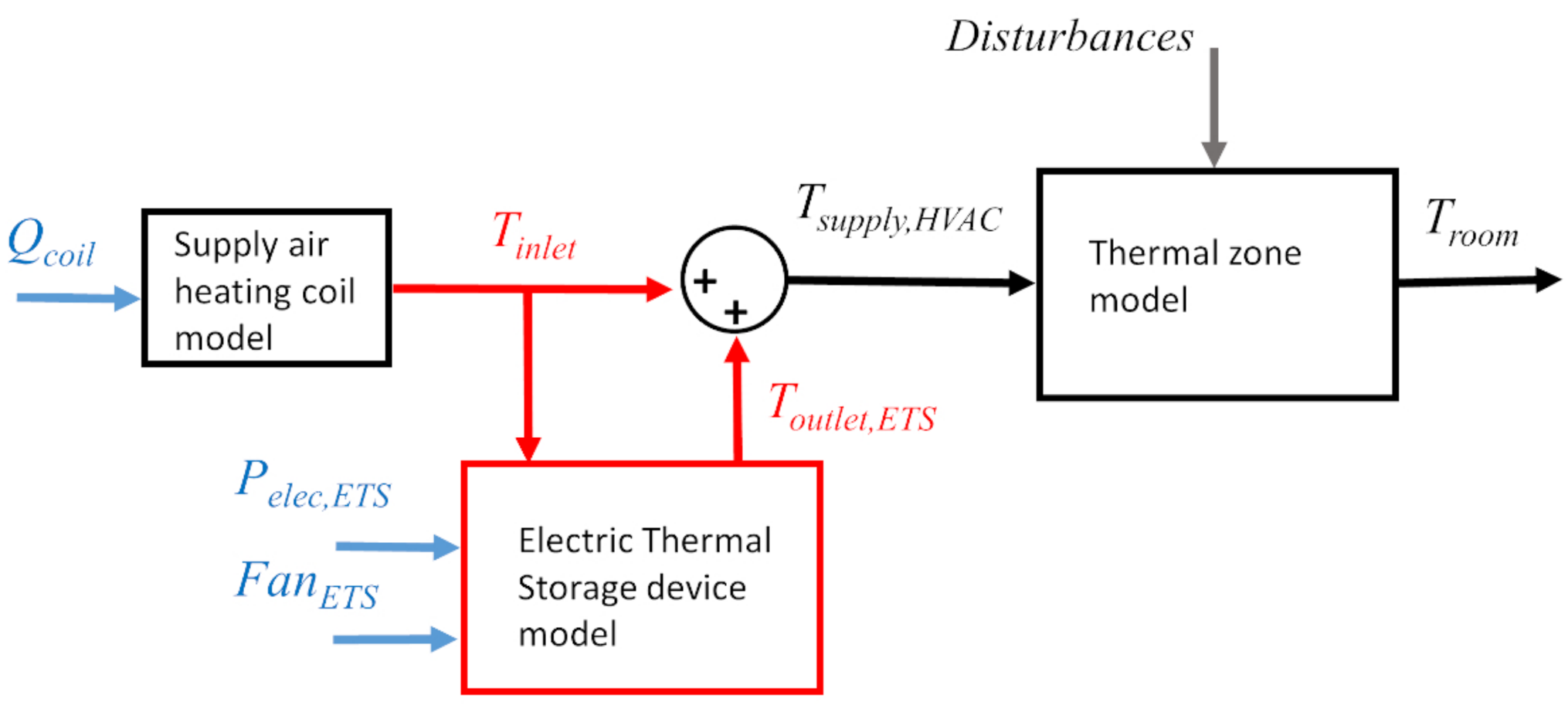

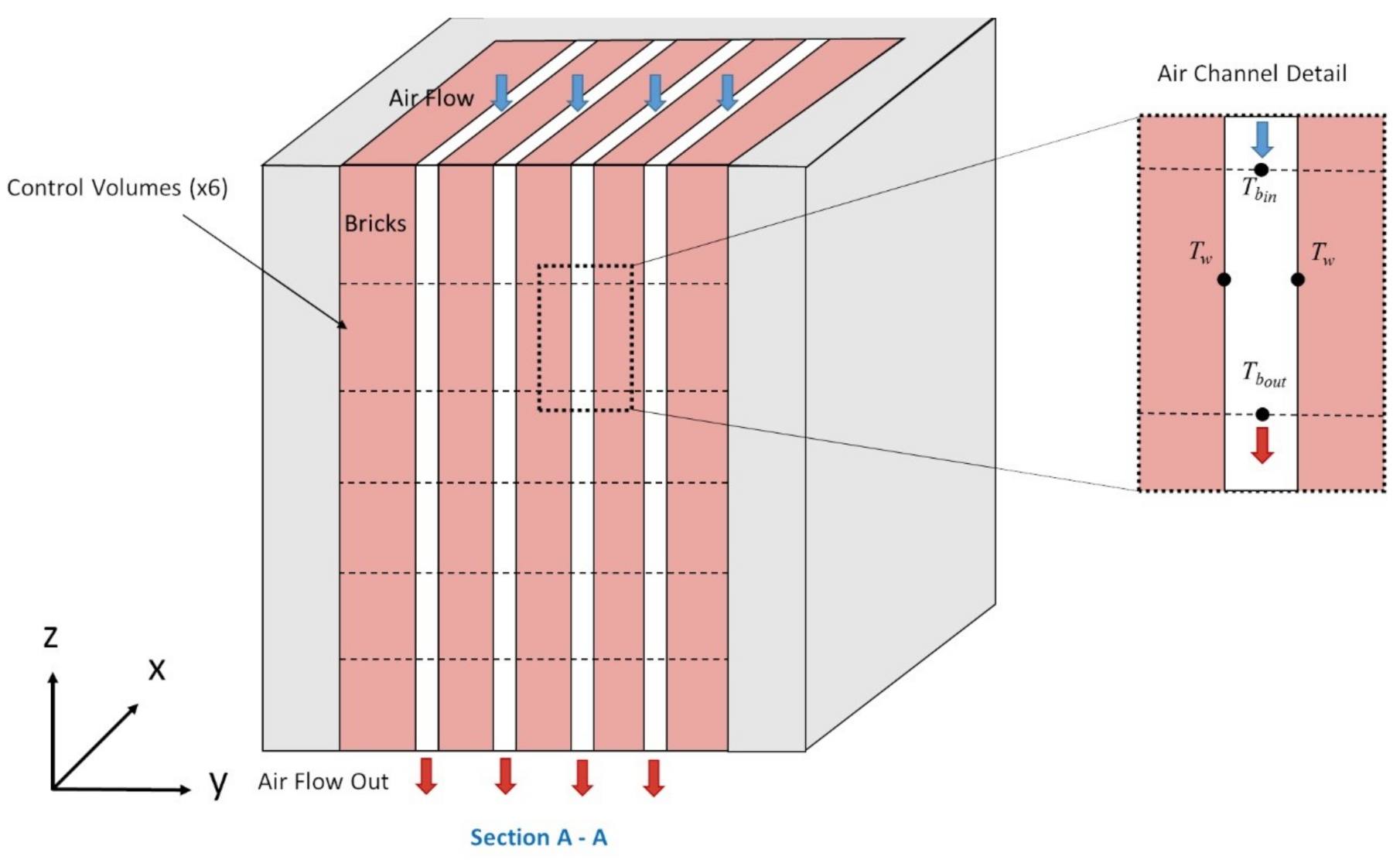





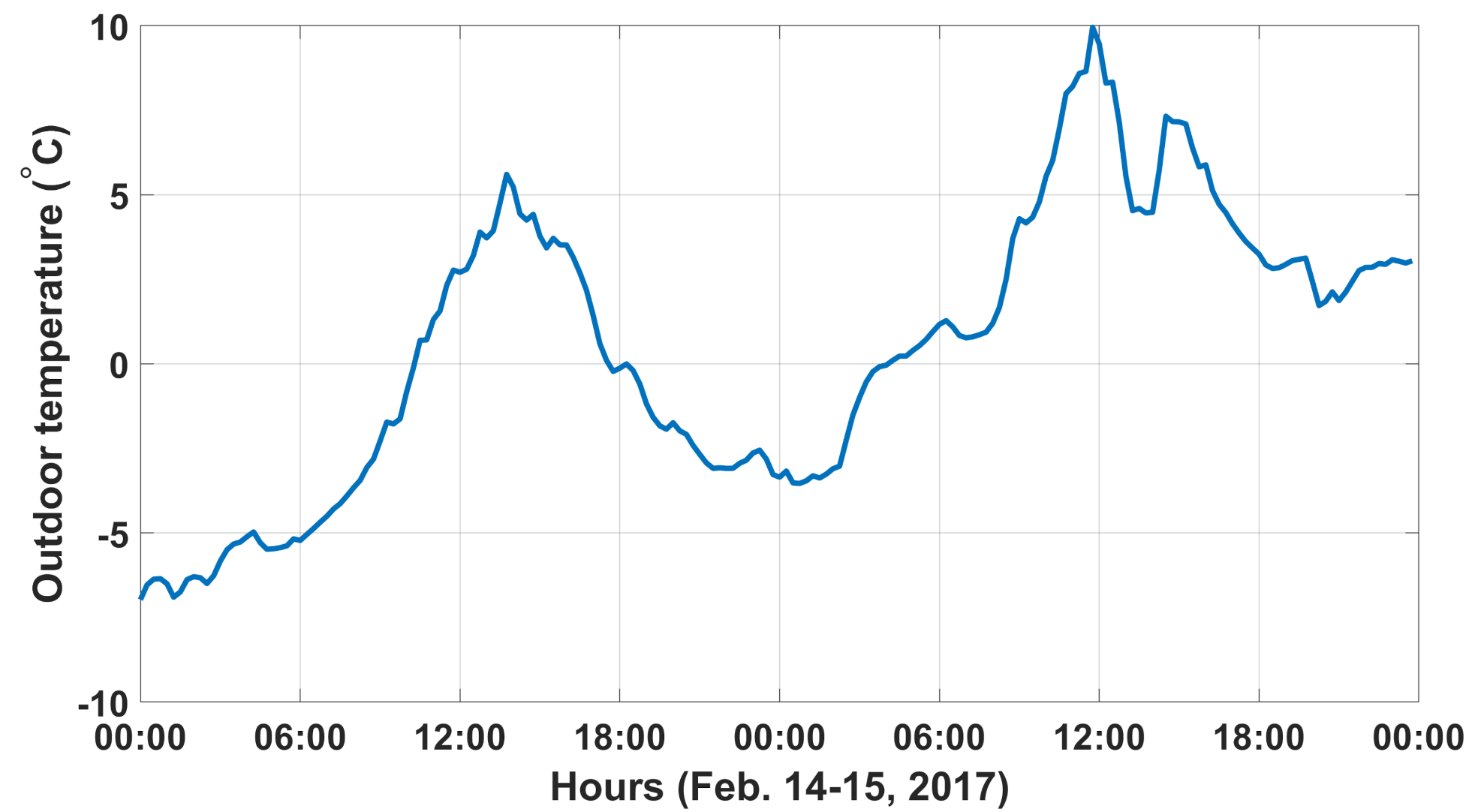
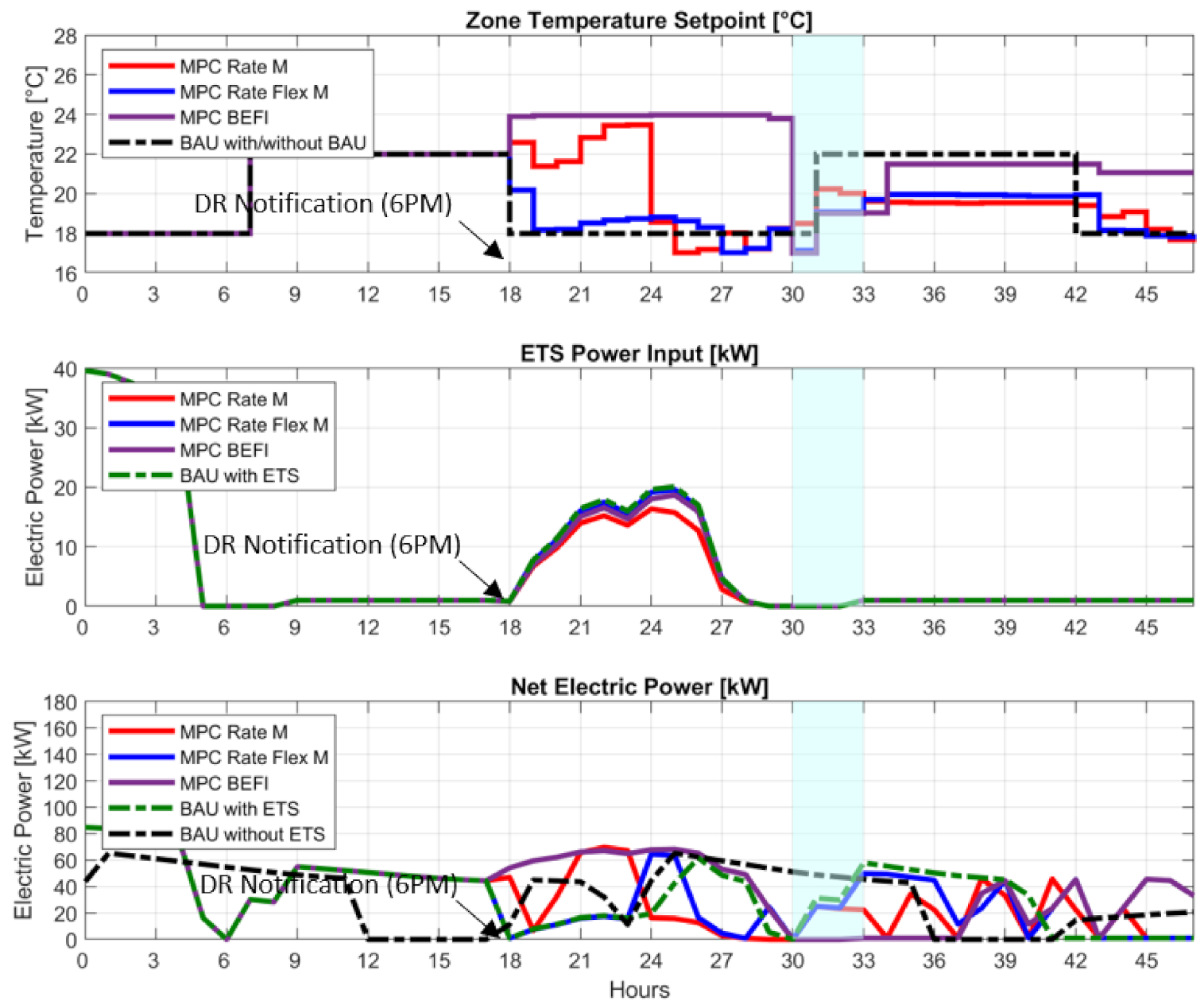


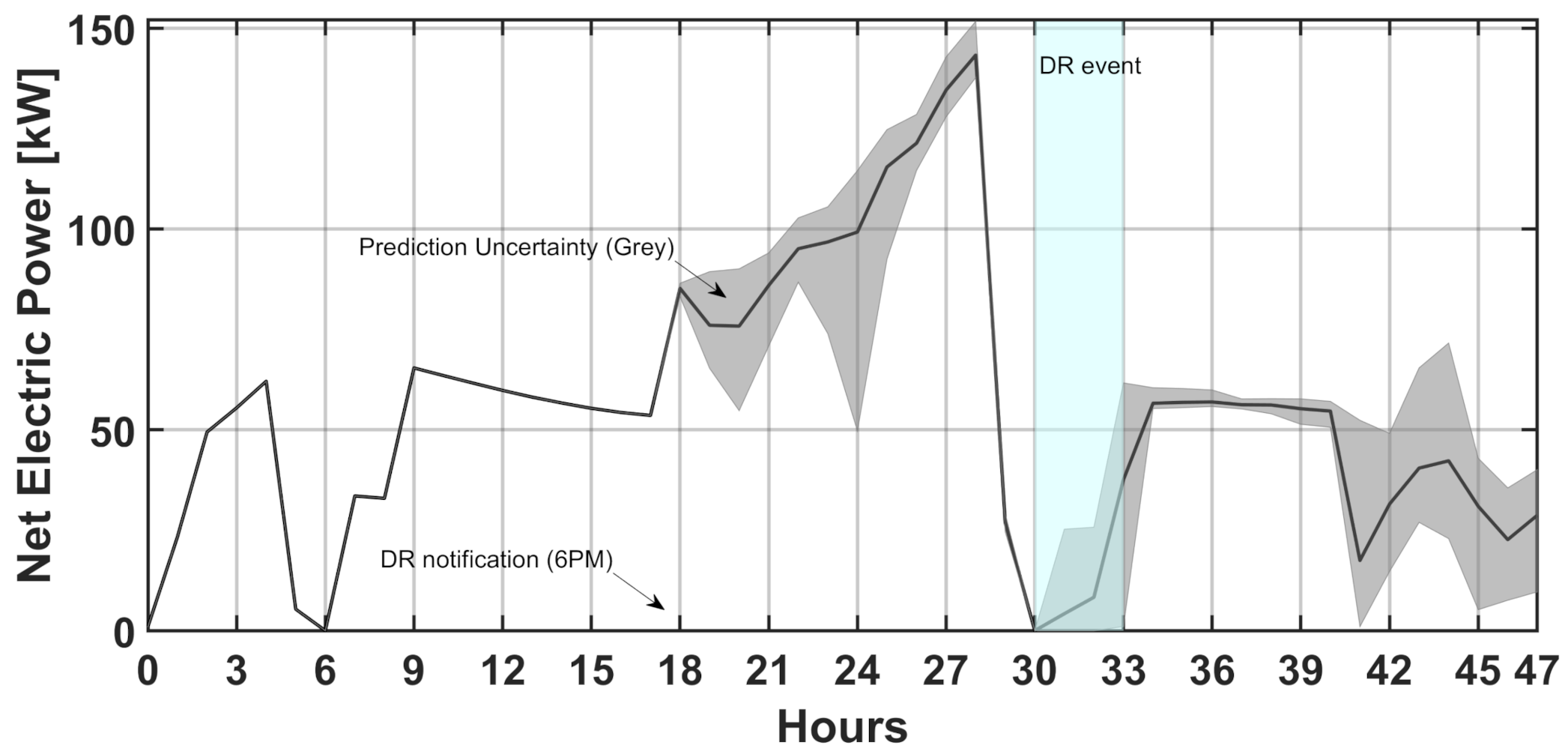

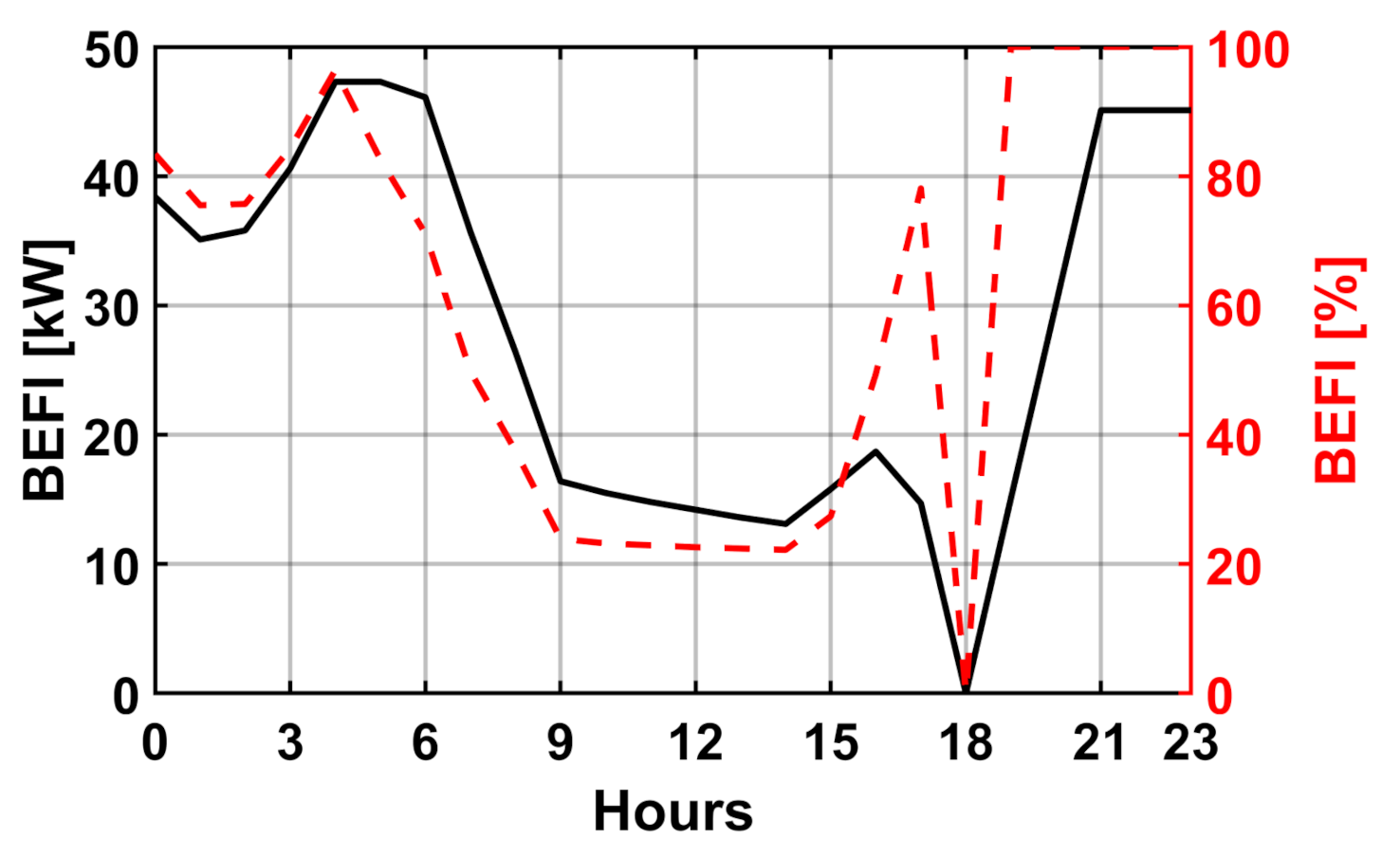

| Parameter | Value |
|---|---|
| Electric Charging Input | 106 kW |
| Thermal Storage Capacity | 640 kWh |
| Storage Material | High-density ceramic bricks |
| Number of Heating Elements | 24 |
| Maximum Brick Temperature | 871 C |
| Weight of Bricks | 3121 kg |
| Number of Bricks | 384 |
| Rate M Large Commercial Building Sector | |
|---|---|
| Demand Charge | $14.58/kW |
| First 210,000 kWh energy consumed | 5.03¢/kW |
| Remaining energy consumbed | 3.73¢/kW |
| Rate Flex M Large Commercial Building Sector | |
| Winter 1 Dec.–31 Mar. | |
| Demand Charge | $14.58/kW |
| Price of energy consumed outside peak events | 3.17¢/kW |
| Price of energy consumed during peak events | 50.00¢/kW |
| Summer 1 Apr.–30 Nov. | |
| Demand Charge | $14.58/kW |
| First 210,000 kWh energy consumed | 5.03¢/kW |
| Remaining energy consumbed | 3.73¢/kW |
| Brick Temperature | ||
|---|---|---|
| 0 C | 0% | 93 C |
| −18 C | 100% | 871 C |
| BAU without Thermal Storage | BAU with Thermal Storage | MPC: Rate M | MPC: Rate Flex M | MPC: BEFI | |
|---|---|---|---|---|---|
| 12 h ahead notification of DR event (18:00) | |||||
| Event Peak (kW) (6 a.m.–9 a.m.) | 73 | 33 | 31 | 0 | 0 |
| Wh/m in | 763 | 1170 | 905 | 1034 | 1321 |
| BEFI (kW) (6 a.m.–9 a.m.) | – | 36 | 36 | 65 | 65 |
| BEFI (%) (6 a.m.–9 a.m.) | – | 55 | 56 | 100 | 100 |
| 4 h ahead notification of DR event (2:00) | |||||
| Event Peak (kW) (6 a.m.–9 a.m.) | 73 | 33 | 28 | 25 | 0 |
| Wh/m in | 659 | 844 | 641 | 633 | 945 |
| BEFI (kW) (6 a.m.–9 a.m.) | – | 36 | 38 | 48 | 65 |
| BEFI (%) (6 a.m.–9 a.m.) | – | 55 | 59 | 74 | 100 |
| BAU without Thermal Storage | BAU with Thermal Storage | MPC: Rate M | MPC: Rate Flex M | MPC: BEFI | |
|---|---|---|---|---|---|
| 12 h ahead notification of DR event (18:00) | |||||
| Event Peak (kW) (6 a.m.–9 a.m.) | 65 | 31 | 25 | 25 | 0 |
| Wh/m in | 490 | 454 | 389 | 386 | 614 |
| BEFI (kW) (6 a.m.–9 a.m.) | – | 25 | 41 | 41 | 57 |
| BEFI (%) (6 a.m.–9 a.m.) | – | 55 | 68 | 75 | 100 |
| 4 h ahead notification of DR event (2:00) | |||||
| Event Peak (kW) (6 a.m.–9 a.m.) | 65 | 31 | 26 | 24 | 0 |
| Wh/m in | 456 | 443 | 259 | 328 | 395 |
| BEFI (kW) (6 a.m.–9 a.m.) | – | 25 | 41 | 41 | 57 |
| BEFI (%) (6 a.m.–9 a.m) | – | 55 | 71 | 72 | 100 |
Publisher’s Note: MDPI stays neutral with regard to jurisdictional claims in published maps and institutional affiliations. |
© 2021 by the authors. Licensee MDPI, Basel, Switzerland. This article is an open access article distributed under the terms and conditions of the Creative Commons Attribution (CC BY) license (http://creativecommons.org/licenses/by/4.0/).
Share and Cite
Date, J.; Candanedo, J.A.; Athienitis, A.K. A Methodology for the Enhancement of the Energy Flexibility and Contingency Response of a Building through Predictive Control of Passive and Active Storage. Energies 2021, 14, 1387. https://doi.org/10.3390/en14051387
Date J, Candanedo JA, Athienitis AK. A Methodology for the Enhancement of the Energy Flexibility and Contingency Response of a Building through Predictive Control of Passive and Active Storage. Energies. 2021; 14(5):1387. https://doi.org/10.3390/en14051387
Chicago/Turabian StyleDate, Jennifer, José A. Candanedo, and Andreas K. Athienitis. 2021. "A Methodology for the Enhancement of the Energy Flexibility and Contingency Response of a Building through Predictive Control of Passive and Active Storage" Energies 14, no. 5: 1387. https://doi.org/10.3390/en14051387






